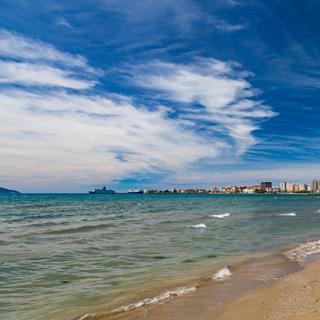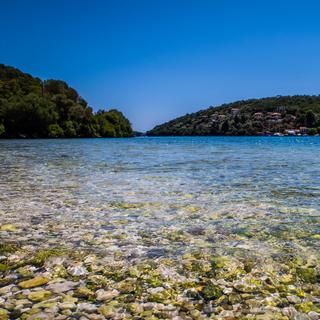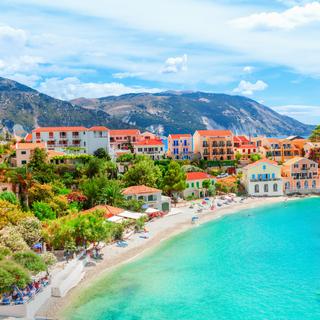
Zakynthos weather and climate

Zakynthos weather and climate
Day
31 °C
Night
21 °C
Sea
25 °C
Precipitation
8 mm
in month
Rainy days
1 days
in month
Daylight
13 hours
average
Sunshine
12 hours
average
Humidity
62 %
Weather charts for Zakynthos
Destinations nearby and activities
Destinations nearby
Activities in Zakynthos

Find more destinations like this
Destinations with similar weather to Zakynthos
Other destinations in Greece - West coast
Closest cities for Zakynthos
Weather overview for Zakynthos
Weather overview
Zakynthos, a picturesque island in Greece, is known for its typically warm Mediterranean climate. Throughout the year, daytime temperatures span a range from an average low of 14 °C (57 °F) in the heart of winter to a peak average high of 31 °C (88 °F) during the heat of August. With an arid period in July witnessing barely 1 day of rainfall, contrasted starkly by the wetter month of December accumulating up to 12 days of precipitation. Nightly lows dip to about 7 °C (45 °F) in the chilly February evenings and ascend to a balmy 21 °C (69 °F) during August nights. Sea temperatures invite swimming, reaching their zenith in August at 25 °C (78 °F), while the coldest waters can be braved in March at a refreshing 15 °C (59 °F).
January weather
January's daytime temperatures hit their minimum, averaging 14 °C (57 °F), while the sea begins a slight cooling trend setting at 16 °C (60 °F). Observations confirm the beginning of a reduction in rainy days, tallying an average of 11 days, along with the start of a decline in precipitation volumes, estimated at 138 mm (5.42 in). Nighttime temperatures mirror this downtrend, averaging at around 8 °C (46 °F).
February weather
In February, the sea temperature drops slightly, with an average of 15 °C (59 °F), and the coldest night temperatures can be felt. Precipitation volumes are also on the decline, averaging at 90 mm (3.53 in). The quantity of sunny hours starts to increase, and the wind speed reaches its annual peak, averaging 4.
March weather
March is distinctly marked by the lowest sea temperatures of the year, holding steady at 15 °C (59 °F), while a subtle uptick in daytime temperatures begins, reaching an average of 16 °C (60 °F). A decrease in the number of rainy days can be noted, as they average out at 8 days, and the volume of rainfall continues its downward trajectory, reporting at 78 mm (3.08 in). An increase in sunny hours is recorded, along with an initial rise in nighttime temperatures, now averaging 9 °C (48 °F).
April weather
April marks the continuation of rising daytime temperatures, with an average of 19 °C (66 °F). A further increase in sea temperatures can be witnessed. The trend of fewer rainy days carries on, with an average of 6 days, while rainfall quantities also maintain their descent, esting at 44 mm (1.74 in). Overnight temperatures climb, averaging 11 °C (51 °F), and the lengthening of sunny hours proceeds.
May weather
As May heralds the approach of summer, Zakynthos sees further elevation in daytime temperatures, now averaging 24 °C (75 °F). Sea temperatures also exhibit a marked rise, recording an average of 19 °C (65 °F). The decline in both the frequency of rainy days, averaging 3 days, and the amount of rainfall continues. Nighttime temperatures also ascend, averaging 14 °C (57 °F), alongside the number of cloud-free sunny hours which are on the rise.
June weather
June, with the onset of the tourist season, showcases a significant increase in sea temperatures to an average of 22 °C (71 °F) and is accompanied by a rise in daytime temperatures to 28 °C (82 °F). Memorable holiday weather is characterized by the scant presence of rain, amounting to an average of 2 days. Nighttime temperatures edge higher, averaging 18 °C (64 °F).
July weather
July's continued tourist bustle is underscored by rising sea temperatures, which now average 24 °C (75 °F). The escalation of daytime temperatures is evident, with an average of 31 °C (88 °F). The rarity of rainy days hits its yearly low, averaging just 1 day, alongside minimal volumes of rainfall. The number of sun hours is at its annual zenith.
August weather
Throughout August, daytime temperatures peak, reaching an average of 31 °C (88 °F), correlating with the highest sea temperatures observed. The intensely popular tourist season is in full swing, paralleled by a notably dry climate. With evening temperatures reaching their warmest, the hours of sunshine begin to decrease.
September weather
September witnesses the gradual reduction of sea temperatures, holding an average of 24 °C (76 °F), while daytime temperatures start to decline as well. The number of rainy days begins to inch upwards, with an average of 4 days, and rainfall amounts start to increase, with an average of 46 mm (1.80 in). The tapering of sunny hours continues.
October weather
October in Zakynthos is marked by the continuation of falling daytime temperatures, now averaging 23 °C (74 °F). This reduction is mirrored in shedding sea temperatures as well, averaging 22 °C (72 °F). The number of rainy days grows, averaging 7 days, while rainfall amounts also escalate. Nighttime temperatures descend, and the quantity of sunny hours lessens even more.
November weather
The drop in sea temperatures in November can be palpably felt, averaging at 20 °C (68 °F). Daytime highs also continue their decline, averaging 18 °C (65 °F). The number of rainy days piles up, averaging 10 days, with rainfall volumes growing robustly. The descent in night temperatures is evident, and relative humidity surges, hitting a peak.
December weather
December sees further reduction in daytime temperatures, now at an average of 15 °C (59 °F), in tandem with a marked decline in sea temperatures. The zenith of rainy days is reached, averaging 12 days, and this is matched by the pinnacle of rainfall amounts. The shortest daytime length of the year becomes apparent, alongside the least number of hours of direct sunlight.
FAQs
What is the average number of rainy days in Zakynthos during January?
On average, January in Zakynthos will have about 11 days with rainfall.
How strong is the wind in Zakynthos during February?
Wind speeds in Zakynthos during February can reach an average high of 4.
Are the number of rainy days in Zakynthos during March decreasing?
Yes, there's a notable reduction, averaging around 8 days of rain in March.
What trend can be observed for daytime temperatures in Zakynthos during April?
Daytime temperatures in Zakynthos continue on an upward trend in April, averaging 19 °C (66 °F).
Is the sea temperature in Zakynthos warm enough for swimming by May?
The sea in Zakynthos in May reaches a comfortable average temperature of 19 °C (65 °F), which might be suitable for swimming for some.
What characterizes the weather in Zakynthos during June that makes it ideal for tourism?
June's weather in Zakynthos is characterized by high daytime temperatures averaging 28 °C (82 °F) and a minimal average of 2 days with rain, contributing to superb vacation conditions.
How many days of rain might one expect in Zakynthos during the month of July?
Expect almost no rainy days in Zakynthos in July, with a minimal average of just around 1 day.
How does August compare to other months in terms of high temperatures and tourist attendance?
August stands out with the highest average daytime temperatures and remains a pinnacle for tourism, largely due to the hot and dry weather typical for this time.
As summer ends, what weather shifts occur in Zakynthos during September?
September brings a visible decrease in both sea and daytime temperatures, an uptick in rainy days, and a moderate increase in rainfall amounts as summer concludes.
Does October see a significant increase in rainfall in Zakynthos?
October in Zakynthos does notice a rise in rainfall, with a notable increase in the number of rainy days to an average of 7 days.
With the arrival of November, what changes in the weather in Zakynthos are most prominent?
Notable in November are the descending sea and daytime temperatures, along with a significant rise in both the frequency of rain and humidity levels.
How do daytime and sea temperatures in Zakynthos fare as the year comes to an end?
As the year concludes, Zakynthos experiences a continued drop in both daytime and sea temperatures, with December marking some of the coldest averages.











